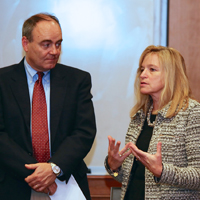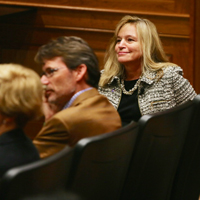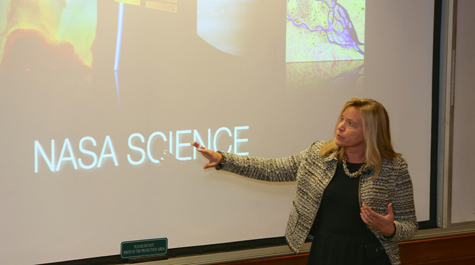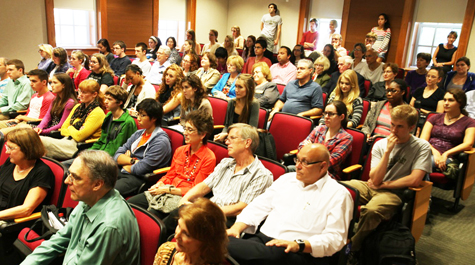Stofan: Space exploration a global initiative
Ellen Stofan ‘83 first became acutely aware of the global nature of science as a doctoral student at Brown University when she wrote her thesis on a Soviet mission to Venus that coincided with her entry into graduate school.
“I went from living in Williamsburg,” Stofan explained, “to living in Providence (R.I.) to living in Russia every summer at what wasn’t a great time (the Cold War). But it showed me from an early stage that space exploration is truly a global initiative.”
Stofan, chief scientist for NASA and principal adviser to NASA Administrator Charles Bolden on science programs and investments, kicked off the Reves Center for International Study’s 25th anniversary celebration finale at William & Mary Thursday with an engaging lecture entitled “Looking Outward, Inward and Homeward: International Cooperation at NASA.”
“I am a huge admirer of the Reves Center and the work they have done to infuse international studies throughout the curriculum here,” said Stofan, who was accompanied by her husband, fellow W&M alumnus Tim Dunn ’83. The Stofans also are parents to two graduates, Ryan ’10 and Emily ’14.
“I have a global perspective in studying the earth,” she continued. “You have to have a global perspective no matter what you study in today’s world. It’s the way the world operates. Whether you’re a scientist or going into law or politics, everything is global.”
Stofan offered insight and data into global warning trends – the planet has gotten warmer over the last 150 years, and is continuing to get warmer. She also explored the three most common themes for which mankind seeks answers: Are we alone? How did we get here? How does the universe work?
She turned her attention to the internationalization of science and space study by saying that NASA’s budget at the height of the Apollo program represented 4 percent of the federal budget. Today it accounts for just 0.4 percent.
“Without a geo-political reason for doing things, how could we do them?” she asked. “We make it onto the front page of the paper at least once a month for the science we are doing. And by ‘we’ I mean the global science community.”
Forty-four of the 60 current operational science missions feature an international component – and the ratio for future missions is even higher.
For example, a current mission to measure precipitation around the globe every three hours features a Japanese spacecraft that was launched in Japan with American and Japanese instruments.
“It gives us an important insight into the earth’s climate cycle,” she said. “That’s a typical example of everything that we do being international.”
But the best example of global cooperation, she said, is the international space station.
The project’s primary partners are Japan, Canada, Russia, the United States and the European Space Agency, which features 20 states. However, through March, 83 countries had participated in research. On board presently are two U.S. astronauts, one German and three Russians.
“Lots of people say it should be nominated for a Nobel Prize,” Stofan said.
 There is, she said, a “ton of research” conducted on the station.
There is, she said, a “ton of research” conducted on the station.
“In addition to medical research, we are testing technologies to help us get humans ready to be sent to Mars or beyond the lower orbit,” she said. “In zero gravity, our cardiovascular system doesn’t work as well. Some bacteria become more virulent in space, some less virulent. Our immune system doesn’t work as well. Things are happening in the body at the genetic level and so what we can do is take that information – whether from a fruit fly, mouse or human – and start using it to understand how the human body works. How can we use that info to help address disease, to address the process of aging?
“And, again, we’re not doing it just for the United States, we’re doing it internationally.”
Earlier in her career, Stofan was an administrator on two shuttle missions. She was asked what precautions are taken to make sure that astronauts from different countries, together in a confined space for a long period of time, get along. There’s a rigorous training program that starts more than a year before the mission, she said, in which the crew spends a lot of time together.
“And we tell them, ‘Don’t talk politics,’” she added with a smile.
















